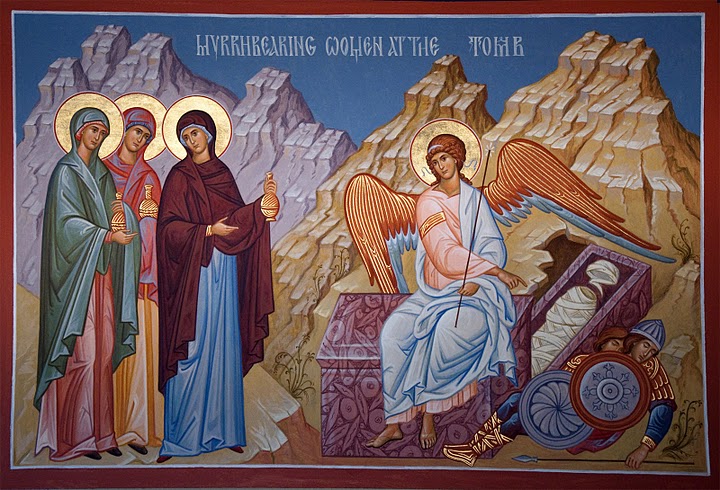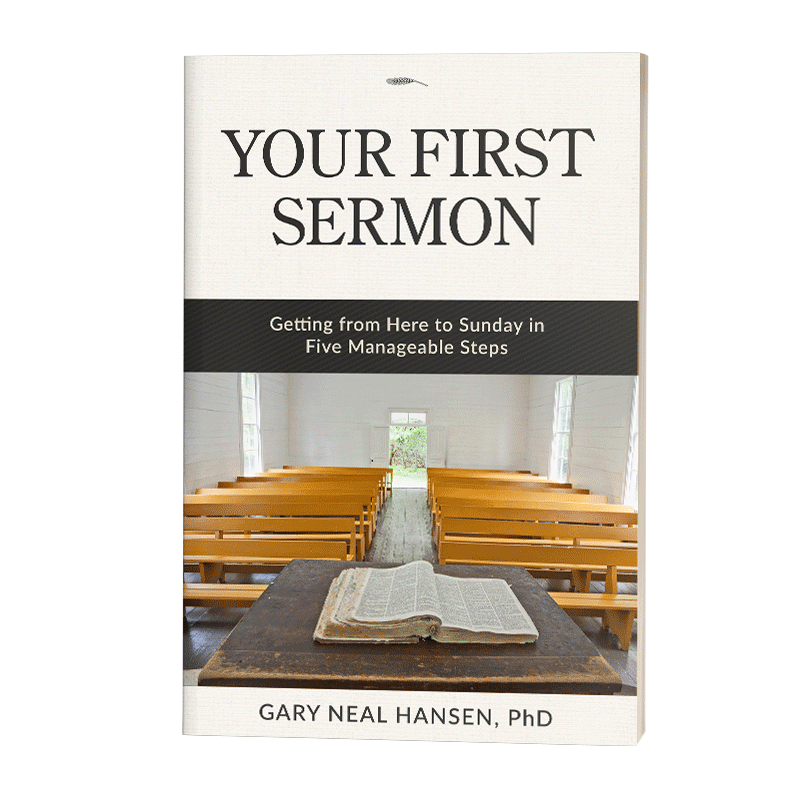
The Myrrh-Bearing Women
And so we come to Easter! In Year B the text is Mark 16:1-8, which is the story of what Orthodoxy remembers as “The Myrrh-bearing women.” (There is also an Easter text from John this year, but I’m opting to stick with Mark.)
I’m writing and posting this early in Holy Week. As will be familiar to all who preach in this season it seems slightly surreal: I’ve just had Palm Sunday and have yet to experience Maundy Thursday or Good Friday, but I must think ahead to the Resurrection.
Mark’s Gospel seems to come to an end with this passage, though it famously has a “second ending” that has the sound of something tacked on later, perhaps to spackle over a distinctive and odd feature of this first ending. This passage is full of emotion, despite its brevity, which is part of its message, really.
The Myrrh-Bearing Women
The story picks up on Holy Saturday, actually. On Friday afternoon the women disciples saw where Jesus’ body was entombed. From sundown Friday to sundown Saturday, faithful Jews that they were, they kept Sabbath, resting from work and, as much as humanly possible, even laying aside grief.
Then, “When the sabbath was over,” i.e., Saturday evening,
Mary Magdalene, and Mary the mother of James, and Salome
bought spices, so that they might go and anoint him.Mark 16:1 NRSV
In Orthodoxy, the myrrh-bearing women are remembered in icons and hymns. They get sung about very regularly, actually. Since every Sunday is a miniature re-living of Easter, they are sung, prayed, and read about in Saturday Vespers and Sunday Matins.
Yes, Orthodoxy has only male clergy, but in their worship they speak, pray, and sing about women far more often than any Protestants I’ve encountered.
These myrrh-bearing women show a beautiful faithfulness, willing to come and do a hard thing for someone they loved, despite sorrow and probably danger. (Less danger in Mark perhaps, where there are no guards mentioned at the tomb.)
So, Sabbath rest over, when the shops reopened Saturday evening they picked up all the materials needed to properly anoint the body of a loved one.
The spices, remembered as myrrh, nicely echo the gifts of the Magi in Matthew’s nativity narrative. Mark does not actually state that it was myrrh.
It is John’s Gospel that mentions myrrh, brought not by the women but by Nicodemus. Mark’s explicit reference to myrrh was at the crucifixion, when wine mixed with myrrh was offered to Jesus.
So we think of myrrh as a burial reference but in the OT it is seen as an ingredient in the holy anointing oil and as a perfume, especially in the Song of Solomon. It leads me to ponder the death of Jesus in connection with his role as anointed prophet, priest, and king, as well as his role as bridegroom, united to the Church in marriage.
The Young Man
Once the women arrive they find the great stone door rolled away from the tomb. They step inside to find not Jesus but – whom?
Many of us eagerly fill in the blank: an angel. Or maybe two depending on which Gospel we’ve been reading.
But Mark doesn’t say there was an angel, does he? No: it’s a young man, dressed in white but not, apparently, shining with borrowed splendor from standing in the presence of God.
Who is this guy?
Here’s a tantalizing connection: Back in Gethsemane Mark said “a certain young man dressed only in a linen cloth” fled the scene – naked, actually. Had one of the soldiers grabbed the hem, trying to catch the fellow, who figured it was better to run through town alfresco than spend the night a prisoner?
Well what if this certain young man went back and picked up his linen, or maybe stopped home for his bathrobe, then went to the cemetery to pay his respects? And then, perhaps he was first to meet the risen Christ, who said to pass on a message to the myrrh-bearing women when they showed up?
Give this theory all the credit it deserves – which is none at all. The text does not designate the young man as one of those mysterious creatures the angels, but certainly he plays the role of messenger – which is precisely the meaning of the word “angel.”
Plus he uses the stock first line of most angelic encounters: “Don’t be alarmed!”
And thus we have the core of the first Easter encounter. The myrrh-bearing women do not encounter the risen Christ. They bump into a stranger where they thought they’d find Jesus’ body, and by this stranger’s witness they understand that Jesus is alive.
It is worth noting that their experience is not unlike our own.
And Peter
Among the interesting features of this encounter is that the myrrh-bearing women are given a calling, a mission: “…go, tell…” says the stranger.
It is often said that they were commissioned to be the fist evangelists. True enough – though their mission was within the Church, not to the world at large. “…go, tell his disciples…” they are told.
Interesting, though, their commission goes one step further:
…go, tell his disciples AND Peter…”
Mark 16:7 NRSV
This makes it quite clear that, at least in the eyes of the young man in white, Peter was not currently counted among Jesus’ disciples.
Maybe after the Certain Young Man ran off naked from Gethsemane, he picked up his bathrobe and made Jesus’ trial his first stop. Maybe he heard Peter deny three times that he even knew Jesus – with curses, no less.
Peter himself was probably wondering whether he could carry the title “disciple” any more, much less “apostle.”
Lovely that the first mission from the first Easter encounter included reconciling the heart-sore man who had apostatized so egregiously.
Maybe we should consider this Easter a time to welcome home those we know who have strayed far into the same kinds of troubles.
He Goes Before You
There is another lovely note hidden within the commission to the myrrh-bearing women, one that we would do well to meditate long upon.
Where is the risen Christ, they wonder?
…he is going ahead of you to Galilee; There you will see him, just as he told you.
Mark 16:7 NRSV
Ah yes, we ask that question too: Where is the risen Christ?
Well, the creed tells us he’s ascended into heaven – gone before us, where we will see him, just as he told us.
But isn’t there a sense that it remains true down here, all the while, throughout our lives?
We long for the moments, the events or the seasons, when Jesus seems to be right here beside us.
But most of the time he is going before us, traveling first where we will go, preparing the way for us to do his will and be changed into his image.
And many times, after we go to these places life sends us, though we don’t see him with our eyes, we walk away convinced that he really was there all the while – just as he said.
They Said Nothing
Ah, and then the end of the Easter story: Jesus comes by, shows them his wounds, big hugs all around… Actually no. That’s it. Mark doesn’t record a meeting with Jesus. Just a message from a stranger.
But they fulfilled their commission, right? They were the first evangelists after all.
Actually no. They were pretty wrecked by the whole scene. What kinds of emotions does Mark say they felt?
- Alarm.
- Terror.
- Amazement.
- Fear.
How much of the message did they share? Just how far and how wide did the first evangelsts spread the word?
…they said nothing to anyone, for they were afraid.
And that, dear reader, is how the experience of most modern Christians is just like the real experience of the very first Easter.
My prayer for you this Easter is that you will find Jesus going before you wherever you go. And that finding that he was mysteriously there all along will give bring new and lasting life, as well as the counter-cultural courage to tell others about him.
++++++++++++
Preaching this text? If you want a refreshing take on making your sermon both biblical and useful to the people who listen, check out my book Your First Sermon: Getting from Here to Sunday in Five Manageable Steps.
Amazon reviewers consistently say it has great input for seasoned preachers as well as first-timers. Click the affiliate link to check it out on Amazon.


Leave a Reply